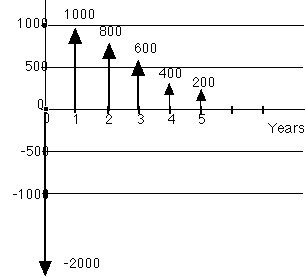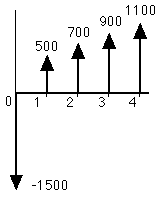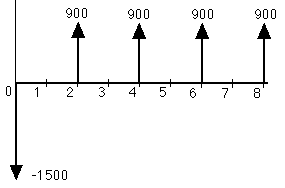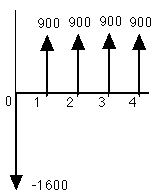![]()
1. Gary is considering buying a piece of land to set up a survival games course. Operating expenses are expected to be $2000/yr over the life of the project. Income from the project is expected to be $3000 in year one, and increase $1000/yr. thereafter. After five years he plans to stop running the course and he will donate the land to the city (meaning no salvage value). All these costs and revenues are estimated in today's prices, however, all actual dollar cash flows are expected to increase with an 8% per year inflation rate. This is the general inflation rate.
a. How much should he pay for the land in order to get a 10% rate of
return? This minimum rate of return includes the effect of the 8% general
inflation rate. Neglect taxes in this analysis.
1.b. Include taxes in the analysis of Problem 1. Use
$14,030 as the investment in the project. Assume straight-line depreciation
and a 40% tax rate. What after tax rate of return does Gary make on the
project?
![]()
2. An investor is considering the purchase of a bond originally offered by the Westinghouse Company. The bond will mature in 8 years at which time Westinghouse will pay the investor the face value of $1000. Westinghouse also pays simple interest to the investor each year. The interest is equal to 6% of the face value of the bond. Assume the interest payments are end of the year payments with the first payment one year from now. The revenues obtained from the bond are fixed and not affected by inflation or deflation of the value of money.
The investor's real MARR is 25%. This is her required return on investment if there were no inflation or deflation in the value of money.
a. Assuming no inflation or deflation in the value of money in the future, what should the investor pay for the bond?
b. If the investor expects a general inflation rate of 16% per year for the next 8 years, how much should she be willing to pay for the bond?
c. If the investor instead expects a general deflation rate of 18% per year for the next 8 years, how much should she be willing to pay for the bond?
![]()
3. An investment of $2000 will result in the estimated cash flow below. The general rate of inflation is 6% and future cash flows are expected to increase at the same rate as general inflation.

a. Compute the cash flow in actual dollars.
b. Your minimum acceptable rate of return without considering inflation is 10%. Should you accept this investment opportunity?
c. Say you must pay taxes on the incomes shown in the figure. The investment for the project is to be depreciated with the sum of year's digits method. The future incomes are expected to increase with an inflation rate of 6%. The tax rate is 40%, the tax life is 5 years, and the tax and actual salvage are zero. The after tax MARR without considering inflation is 10%. Is this an acceptable investment?
![]()
4. An investment in a labor savings device of $1,000 results in a savings of $200 per year for five years. The device can be sold for $1,000 at the end of the five year period. The savings and salvage values are estimated in real-value dollars. The general inflation rate is expected to be 6% per year during the five year period. What is the rate of return for this investment, including the effects of inflation?
![]()
5. Your brother needs a $5,000 loan to go to college. Because of his poverty, he will pay nothing for the next four years. Five years from today he will begin paying you $2500 a year for the next 4 years. The first payment occurs 5 years from today and the total of the four payments will be $10,000.
a. First consider the investment without inflation. If your minimum rate of return is 8%, is this an acceptable investment?
b. For the same payment schedule but with a 5% rate of inflation, is this an acceptable investment? Note that your brother pays you $2500 a year regardless of the inflation rate. Your real MARR is 8%.
![]()
6a. In each case I want you to write the formula that you would use to evaluate the investment described by the cash flow on the left. In all cases the inflation rate is 5%. Use as few time value of money factors in the formula as possible. Use numerical interest rates in the formula.
a. Life = 4 years. The cash flow is in real dollars. The MARR including the effects of inflation is 20%.
Write the formula for the NAW expressed in real dollars.

b. Life = 8 years. The cash flow is in actual dollars. The MARR including the effects of inflation is 20%.
Write the formula for the NAW expressed in real dollars.

c. The cash flow is in actual dollars.
Use Straight line depreciation.
The tax rate is 40%. The tax and actual salvage are zero.
The after tax MARR not including the effects of inflation is 10%.
Write the formula for the after tax NPW.

![]()
7. A process requires an initial investment of $100,000, has a ten year economic life, has a salvage value of $30,000 at the end of its economic life, and has operating costs of $40,000 per year. Revenue attributable to the process is $80,000.
We expect a general inflation rate of 4% during the next 10 years. The operating cost and salvage value are fully responsive to inflation (increase at the same rate as general inflation), but the revenue is not responsive to inflation (does not change with inflation).
Find the before-tax equivalent present worth of the process. The before-tax minimum acceptable rate of return is 20% with no adjustment for inflation. Is this an acceptable investment?
![]() 8. A young man has a new baby girl. The man is currently
attending Texas A&M University, but his life-long dream was to attend
U.T. He vows to send his daughter to U.T., and plans to establish a savings
program to accomplish this objective. The current annual cost of attending
U.T. is $10,000. The prudent young father knows inflation will affect that
amount and estimates a conservative 6% per year general inflation. He assumes
college costs will inflate at the rate of general inflation.
8. A young man has a new baby girl. The man is currently
attending Texas A&M University, but his life-long dream was to attend
U.T. He vows to send his daughter to U.T., and plans to establish a savings
program to accomplish this objective. The current annual cost of attending
U.T. is $10,000. The prudent young father knows inflation will affect that
amount and estimates a conservative 6% per year general inflation. He assumes
college costs will inflate at the rate of general inflation.
Assume the daughter will begin college 18 years from now and will attend for 4 years. Tuition must be paid at the beginning of each year. Help the small child escape the terrible fate of her father by providing the following information.
a. What will be the tuition for each of the four years of college in actual dollars?
b. How much money must the father have saved in actual dollars by the girl's 18th birthday if the savings are to pay the college costs of the four years? No deposits will be made after the 18th birthday, but money will be left in savings until required. Assume the savings account earns 10% interest.
c. If the father deposits a fixed amount in actual dollars each year
(starting one year from now and ending at year 18) how much money must he
deposit each year to reach the goal determined in part b?
![]()